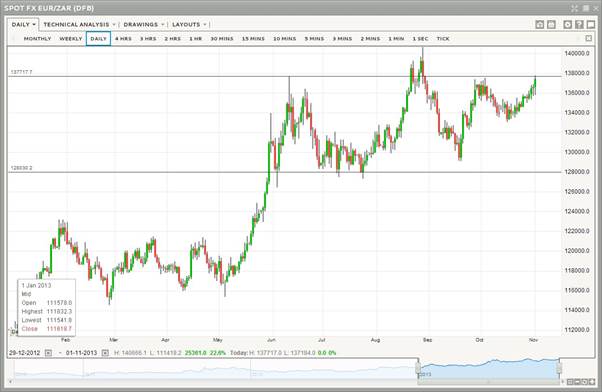The EUR/ZAR tested the resistance level of 13.77 on Friday last week but failed to close above the level, retracing to a close of 13.74.
Back in mid-June it reached a high of 13.75 after rallying the previous six weeks from the low of 11.60.
Written by Tarik Chebib who works on IG’s dealing floor in London. To learn more about the financial markets in South Africa visit: https://www.ig.com/za
Nonetheless, since then the pair has established a firm trading range. It retraced subsequent to the first high in mid-June to lows of 12.80 in late July before resuming its uptrend to 13.75 throughout August.

This time the bulls were strong enough to breach the 13.75 level and continued all the way to 14.06 before the bears pushed the pair back down below 13.00 in late September. Ever since, it has been a similar story with the pair testing the 13.75 resistance level multiple times.
The questions now is whether the bulls will remain in the driving seat and be able to break out of the trading range and into previous highs above 14.00?
The South African rand (ZAR) has lost more than 23% in value compared to the euro (EUR) this year. Can this be attributed to a strong EUR or is the ZAR just performing poorly? This can be answered by looking at how the ZAR compares against other major currencies such as the USD (-20%) or GBP (-18%). This hints that the major driver for this decline being the ZAR.
At the moment the South African economy suffers from multiple challenges. Its economic growth relies heavily on commodity prices which have been sluggish at best this year.
Official unemployment figures remain high at 24.7% in the third quarter which were only slightly better than the previous quarter which were 25.6%.
South Africa has an unemployment rate comparable to one of Europe’s worst hit countries Greece –which recorded 27.6% unemployment in July. Unofficial figures paint an even worse picture: joblessness in South Africa is closer to 40%.
Whether tapering starts at the end of the year or we have to wait for March 2014, there is no doubt that monetary policy in first world countries will be tightening up at some point in the near future.
With investors able to achieve higher yields in more stable economies it is likely that higher risk countries such as South Africa will suffer.
Spread bets and CFDs are leveraged products. Spread betting and CFD trading may not be suitable for everyone and can result in losses that exceed your initial deposit, so please ensure that you fully understand the risks involved.
This information has been prepared by IG, a trading name of IG Markets Limited. The material on this page does not contain a record of our trading prices, or an offer of, or solicitation for, a transaction in any financial instrument. IG accepts no responsibility for any use that may be made of these comments and for any consequences that result. No representation or warranty is given as to the accuracy or completeness of this information. Consequently any person acting on it does so entirely at their own risk. Any research provided does not have regard to the specific investment objectives, financial situation and needs of any specific person who may receive it. It has not been prepared in accordance with legal requirements designed to promote the independence of investment research and as such is considered to be a marketing communication. Although we are not specifically constrained from dealing ahead of our recommendations we do not seek to take advantage of them before they are provided to our clients.
